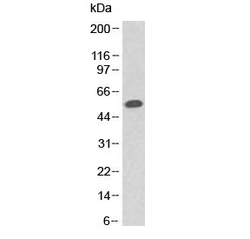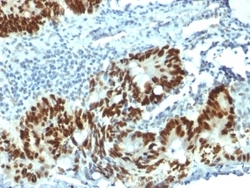Antibody data
- Antibody Data
- Antigen structure
- References [21]
- Comments [0]
- Validations
- Western blot [1]
- Immunohistochemistry [1]
- Protein array [1]
Submit
Validation data
Reference
Comment
Report error
- Product number
- V3514 - Provider product page

- Provider
- NSJ Bioreagents
- Product name
- p53 Antibody / TP53 (N-Terminal Region)
- Antibody type
- Monoclonal
- Description
- Protein G affinity chromatography
- Reactivity
- Human
- Host
- Mouse
- Conjugate
- Unconjugated
- Antibody clone number
- PAb 1801
- Vial size
- 20 µg, 100 µg (with BSA, sodium azide), 100 µg (without BSA, sodium azide), 7 ml (prediluted for IHC)
- Concentration
- 0.2 mg/ml
- Storage
- Store the p53 antibody at 2-8°C (with azide) or aliquot and store at -20°C or colder (without azide).
Submitted references Identification, validation, and targeting of the mutant p53-PARP-MCM chromatin axis in triple negative breast cancer.
The protein interacting with carboxyl terminus-1 codon 389 polymorphism impairs protein interacting with carboxyl terminus-1 function and is a risk factor for uterine cervical cancer.
ErbB2 inhibition by lapatinib promotes degradation of mutant p53 protein in cancer cells.
Prognosis of patients with BRCA1-associated ovarian carcinomas depends on TP53 accumulation status in tumor cells.
Δ40p53 is involved in the inactivation of autophagy and contributes to inhibition of cell death in HCT116-Δ40p53 cells.
Adenocarcinoma arising in multiple hyperplastic polyps in a patient with Helicobacter pylori infection and hypergastrinemia during long-term proton pump inhibitor therapy.
Oral Administration of Tualang and Manuka Honeys Modulates Breast Cancer Progression in Sprague-Dawley Rats Model
SMG7 is a critical regulator of p53 stability and function in DNA damage stress response.
Immunohistochemical Determination of p53 Protein Overexpression for Predicting p53 Gene Mutations in Hepatocellular Carcinoma: A Meta-Analysis.
Molecular Probing of the HPV-16 E6 Protein Alpha Helix Binding Groove with Small Molecule Inhibitors.
Analysis of p53 Protein Expression in Hepatocellular Carcinoma.
Overexpression of stathmin/oncoprotein 18 correlates with poorer prognosis and interacts with p53 in oral squamous cell carcinoma.
Colossolactone H, a new Ganoderma triterpenoid exhibits cytotoxicity and potentiates drug efficacy of gefitinib in lung cancer.
Secondary interaction between MDMX and p53 core domain inhibits p53 DNA binding.
APOBEC3B is an enzymatic source of molecular alterations in esophageal squamous cell carcinoma.
Addiction of lung cancer cells to GOF p53 is promoted by up-regulation of epidermal growth factor receptor through multiple contacts with p53 transactivation domain and promoter.
Reduced MUTYH, MTH1, and OGG1 expression and TP53 mutation in diffuse-type adenocarcinoma of gastric cardia.
Loss of LKB1 and p53 synergizes to alter fallopian tube epithelial phenotype and high-grade serous tumorigenesis.
UBE4B targets phosphorylated p53 at serines 15 and 392 for degradation.
The asphericity of the metabolic tumour volume in NSCLC: correlation with histopathology and molecular markers.
Nedaplatin sensitization of cisplatin-resistant human non-small cell lung cancer cells.
Qiu WG, Polotskaia A, Xiao G, Di L, Zhao Y, Hu W, Philip J, Hendrickson RC, Bargonetti J
NPJ breast cancer 2017;3
NPJ breast cancer 2017;3
The protein interacting with carboxyl terminus-1 codon 389 polymorphism impairs protein interacting with carboxyl terminus-1 function and is a risk factor for uterine cervical cancer.
Yoshimoto M, Tokuda A, Nishiwaki K, Sengoku K, Yaginuma Y
Molecular carcinogenesis 2017 May;56(5):1484-1492
Molecular carcinogenesis 2017 May;56(5):1484-1492
ErbB2 inhibition by lapatinib promotes degradation of mutant p53 protein in cancer cells.
Li D, Marchenko ND
Oncotarget 2017 Jan 24;8(4):5823-5833
Oncotarget 2017 Jan 24;8(4):5823-5833
Prognosis of patients with BRCA1-associated ovarian carcinomas depends on TP53 accumulation status in tumor cells.
Rzepecka IK, Szafron LM, Stys A, Felisiak-Golabek A, Podgorska A, Timorek A, Sobiczewski P, Pienkowska-Grela B, El-Bahrawy M, Kupryjanczyk J
Gynecologic oncology 2017 Feb;144(2):369-376
Gynecologic oncology 2017 Feb;144(2):369-376
Δ40p53 is involved in the inactivation of autophagy and contributes to inhibition of cell death in HCT116-Δ40p53 cells.
Zang Y, Shi Y, Liu K, Qiao L, Guo X, Chen D
Oncotarget 2017 Feb 21;8(8):12754-12763
Oncotarget 2017 Feb 21;8(8):12754-12763
Adenocarcinoma arising in multiple hyperplastic polyps in a patient with Helicobacter pylori infection and hypergastrinemia during long-term proton pump inhibitor therapy.
Anjiki H, Mukaisho KI, Kadomoto Y, Doi H, Yoshikawa K, Nakayama T, Vo DT, Hattori T, Sugihara H
Clinical journal of gastroenterology 2017 Apr;10(2):128-136
Clinical journal of gastroenterology 2017 Apr;10(2):128-136
Oral Administration of Tualang and Manuka Honeys Modulates Breast Cancer Progression in Sprague-Dawley Rats Model
Ahmed S, Sulaiman S, Othman N
Evidence-Based Complementary and Alternative Medicine 2017 ;2017
Evidence-Based Complementary and Alternative Medicine 2017 ;2017
SMG7 is a critical regulator of p53 stability and function in DNA damage stress response.
Luo H, Cowen L, Yu G, Jiang W, Tang Y
Cell discovery 2016;2:15042
Cell discovery 2016;2:15042
Immunohistochemical Determination of p53 Protein Overexpression for Predicting p53 Gene Mutations in Hepatocellular Carcinoma: A Meta-Analysis.
Liu J, Li W, Deng M, Liu D, Ma Q, Feng X
PloS one 2016;11(7):e0159636
PloS one 2016;11(7):e0159636
Molecular Probing of the HPV-16 E6 Protein Alpha Helix Binding Groove with Small Molecule Inhibitors.
Rietz A, Petrov DP, Bartolowits M, DeSmet M, Davisson VJ, Androphy EJ
PloS one 2016;11(2):e0149845
PloS one 2016;11(2):e0149845
Analysis of p53 Protein Expression in Hepatocellular Carcinoma.
Graur F, Furcea L, Mois E, Biliuta A, Rozs AT, Negrean V, Al Hajjar N
Journal of gastrointestinal and liver diseases : JGLD 2016 Sep;25(3):345-9
Journal of gastrointestinal and liver diseases : JGLD 2016 Sep;25(3):345-9
Overexpression of stathmin/oncoprotein 18 correlates with poorer prognosis and interacts with p53 in oral squamous cell carcinoma.
Ma HL, Jin SF, Tao WJ, Zhang ML, Zhang ZY
Journal of cranio-maxillo-facial surgery : official publication of the European Association for Cranio-Maxillo-Facial Surgery 2016 Oct;44(10):1725-1732
Journal of cranio-maxillo-facial surgery : official publication of the European Association for Cranio-Maxillo-Facial Surgery 2016 Oct;44(10):1725-1732
Colossolactone H, a new Ganoderma triterpenoid exhibits cytotoxicity and potentiates drug efficacy of gefitinib in lung cancer.
Chen SY, Chang CL, Chen TH, Chang YW, Lin SB
Fitoterapia 2016 Oct;114:81-91
Fitoterapia 2016 Oct;114:81-91
Secondary interaction between MDMX and p53 core domain inhibits p53 DNA binding.
Wei X, Wu S, Song T, Chen L, Gao M, Borcherds W, Daughdrill GW, Chen J
Proceedings of the National Academy of Sciences of the United States of America 2016 May 10;113(19):E2558-63
Proceedings of the National Academy of Sciences of the United States of America 2016 May 10;113(19):E2558-63
APOBEC3B is an enzymatic source of molecular alterations in esophageal squamous cell carcinoma.
Kosumi K, Baba Y, Ishimoto T, Harada K, Nakamura K, Ohuchi M, Kiyozumi Y, Izumi D, Tokunaga R, Taki K, Higashi T, Miyata T, Shigaki H, Kurashige J, Hiyoshi Y, Iwatsuki M, Iwagami S, Sakamoto Y, Miyamoto Y, Yoshida N, Oki E, Watanabe M, Baba H
Medical oncology (Northwood, London, England) 2016 Mar;33(3):26
Medical oncology (Northwood, London, England) 2016 Mar;33(3):26
Addiction of lung cancer cells to GOF p53 is promoted by up-regulation of epidermal growth factor receptor through multiple contacts with p53 transactivation domain and promoter.
Vaughan CA, Pearsall I, Singh S, Windle B, Deb SP, Grossman SR, Yeudall WA, Deb S
Oncotarget 2016 Mar 15;7(11):12426-46
Oncotarget 2016 Mar 15;7(11):12426-46
Reduced MUTYH, MTH1, and OGG1 expression and TP53 mutation in diffuse-type adenocarcinoma of gastric cardia.
Kohno Y, Yamamoto H, Hirahashi M, Kumagae Y, Nakamura M, Oki E, Oda Y
Human pathology 2016 Jun;52:145-52
Human pathology 2016 Jun;52:145-52
Loss of LKB1 and p53 synergizes to alter fallopian tube epithelial phenotype and high-grade serous tumorigenesis.
George SH, Milea A, Sowamber R, Chehade R, Tone A, Shaw PA
Oncogene 2016 Jan 7;35(1):59-68
Oncogene 2016 Jan 7;35(1):59-68
UBE4B targets phosphorylated p53 at serines 15 and 392 for degradation.
Du C, Wu H, Leng RP
Oncotarget 2016 Jan 19;7(3):2823-36
Oncotarget 2016 Jan 19;7(3):2823-36
The asphericity of the metabolic tumour volume in NSCLC: correlation with histopathology and molecular markers.
Apostolova I, Ego K, Steffen IG, Buchert R, Wertzel H, Achenbach HJ, Riedel S, Schreiber J, Schultz M, Furth C, Derlin T, Amthauer H, Hofheinz F, Kalinski T
European journal of nuclear medicine and molecular imaging 2016 Dec;43(13):2360-2373
European journal of nuclear medicine and molecular imaging 2016 Dec;43(13):2360-2373
Nedaplatin sensitization of cisplatin-resistant human non-small cell lung cancer cells.
Wang H, Zhu X, Huang J, Chen P, Han S, Yan X
Oncology letters 2016 Apr;11(4):2566-2572
Oncology letters 2016 Apr;11(4):2566-2572
No comments: Submit comment
Supportive validation
- Submitted by
- NSJ Bioreagents (provider)
- Main image

- Experimental details
- Western blot testing of human A431 cell lysate with p53 antibody (clone Pab 1801). Expected molecular weight ~53 kDa.
Supportive validation
- Submitted by
- NSJ Bioreagents (provider)
- Main image

- Experimental details
- IHC testing of FFPE human colon carcinoma with p53 antibody (clone Pab 1801). Required HIER: boil tissue sections in 10mM Citrate buffer, pH 6.0, for 10-20 min followed by cooling at RT for 20 min.
Supportive validation
- Submitted by
- NSJ Bioreagents (provider)
- Main image

- Experimental details
- Protein array validation of the p53 antibody: Analysis of HuProt(TM) microarray containing more than 19,000 full-length human proteins using p53 antibody (clone PAb 1801). Z- and S- score: The Z-score represents the strength of a signal that an antibody (in combination with a fluorescently-tagged anti-IgG secondary Ab) produces when binding to a particular protein on the HuProt(TM) array. Z-scores are described in units of standard deviations (SD's) above the mean value of all signals generated on that array. If the targets on the HuProt(TM) are arranged in descending order of the Z-score, the S-score is the difference (also in units of SD's) between the Z-scores. The S-score therefore represents the relative target specificity of an Ab to its intended target.
 Explore
Explore Validate
Validate Learn
Learn Western blot
Western blot Immunocytochemistry
Immunocytochemistry